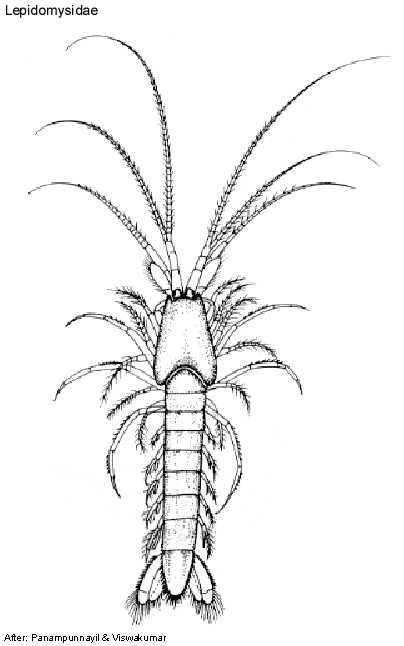 |
||||||
|
|
|
|
|
|
Mysidacea: Families, Subfamilies and TribesKenneth MelandLepidomysidae Clarke, 1961 Diagnostic description. Head. Carapace short, last 2 or 3 thoracic somites exposed dorsally (pleuron of pereonite seven produced posteriorly into lobe). Rostrum broadly rounded. Eyes reduced (to fused or seperate eyeplates). Antenna (antenna 2) scale without apical suture, outer margin smooth, setose, without terminal spine. Labrum symmetric. Mandible lacinia mobilis well developed, spine row present between lacinia mobilis and molar process, molar process well developed. Maxillule (Maxilla 1) endopod with two articles. Thorax. 1st maxilliped exopod small, unarticulated. 2nd thoracopod developed as a gnathopod, exopod well developed. 3rd-8th thoracopods endopod with distinct carpus and propodus, propodus unsegmented. Branchiae on thoracopods absent. Marsupium composed of seven pairs of oostegites. Abdomen 6th & 7th abdominal somites fused. Female pleopods biramous (and of same type found in male). Uropod endopod inner margin with robust setae, statocyst absent; exopod with distal articulation, outer margin with slender and robust setae. Telson apex entire. Generic composition. Lepidomysidae contains 1 genus (9 species); Spelaeomysis Caroli, 1924 (9 species). Remarks. The Stygiomysida families Lepidomysidae and Stygiomysidae where originally placed within the suborder Mysida (see Gordan, 1960). Tchindonova (1981) has later erected the suborder Stygiomysida removing Lepidomysidae and Stygiomysidae from the Mysida. With the exception of Spelaeomysis servatus (Fage, 1924) from the Aldabra Atoll, Zanzibar and S. cochinensis Panampunnayil & Viswakumar, 1991 from a prawn culture field in Cochin, India, the Lepidomysidae are cavernicolous mysids recorded from Otranto, Italy; Trivandrum, India; Cuba and Mexico.
Cite this publication as: 'Meland, K. (2002 onwards). Mysidacea: Families, Subfamilies and Tribes. Version 1: 2 October 2002. https://crustacea.net'. |
|
|
|
|
|
|
|
|
|
Copyright © Australian Museum, 2002 - 2003
Australian Museum website
